Atlantic Monthly Contributors's Blog, page 345
September 17, 2015
Auf Wiedersehen to Germany’s Top Migrant Official

The German official in charge of the office that handles migration and refugees has stepped down from his job, citing, in the words of the country’s Interior Ministry, “personal reasons.”
Manfred Schmidt’s resignation comes as Europe faces the region’s worst refugee crisis since World War II. The country says it expects 800,000 asylum-seekers to enter the country this year alone—four times last year’s total.
Deutsche Welle, the German external broadcaster, reported that Schmidt’s agency, the Federal Office for Migration and Refugees—which is known by its German initials BAMF—was criticized for the pace at which it handled the applications from asylum-seekers. The broadcaster adds:
The BAMF is said to have more than 250,000 unprocessed asylum applications with the average turnaround time averaging more than five months, a stark difference to Germany’s neighbor the Netherlands, which handles cases in an average of eight days.
Schmidt had headed the agency since 2010, and Interior Minister Thomas de Maiziere thanked him for his “extraordinary work.”
Germany is the favored destination for many of the asylum-seekers fleeing civil war in Syria and unrest elsewhere. That, as The New York Times points out, may have been a result of a tweet sent out by Schmidt’s agency.
The migration office posted a message on Twitter on Aug. 25 stating that Syrians refugees would be granted asylum in Germany, regardless of how they had reached the country.
The tweet, based on a technical decision circulated in Mr. Schmidt’s office, was aimed at speeding up the decision time for new asylum applications. But it quickly went viral in the Arabic-speaking world, where the decision was interpreted as Germany throwing open its doors.
But within days, tens of thousands had gathered at Budapest’s Keleti station, chanting “Germany, Germany,” and seeking to travel west and leading Hungarian officials to criticize what it saw as Berlin’s unilateral rescinding of European Union policy.
That effectively rescinded Germany’s pledge to abide by an agreement that requires migrants to apply for asylum in the first European Union country they reach, and it played a crucial role in sparking the mass migration toward Europe in recent weeks.
You can read the rest of our coverage of the refugee crisis here.









September 16, 2015
For 20 Years, Americana Has Celebrated Artistry in Music
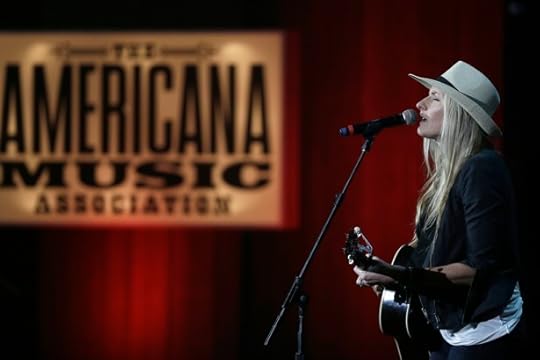
Earlier this year, the former CEO of Sony Music Nashville, Gary Overton, made a controversial statement: “If you’re not on country radio, you don’t exist.” He was pandering a little—his claim came shortly before the Country Radio Seminar, when record-label executives flirt with radio programmers in hopes of getting airtime for their musicians. Overton’s claim sparked no shortage of debate, but there was truth to it: Country radio is the kingmaker for aspiring musicians in the genre, and it doesn’t just want musicians—it wants stars.
For fans who’ve grown weary of the more pop-infused, mass-produced sounds that have come to dominate the country-radio airwaves, Overton’s words are hardly encouraging. The same goes for professional artists who simply want to write, sing, and perform, and who don’t quite fit into the rock or alternative molds. But in the roughly 20 years since it emerged as a radio format, Americana has offered another way for those musicians to exist. Not only do they make music, but they’re increasingly likely to experiment with other genres and come from more diverse backgrounds—and, to top it off, many go on to achieve a degree of mainstream success anyway.
Related Story
The Bro-Country Backlash Is Here
Americana is a fairly broad label, but at its most basic, it’s contemporary music that draws from American roots music styles, such as folk, R&B, bluegrass, and, of course, country. With artists ranging from Lucinda Williams to Carolina Chocolate Drops to St. Paul and the Broken Bones, the result is a sound that’s independent of any single genre. The organizing backbone is the Americana Music Association, which was founded in 1999 in response to artists such as Rosanne Cash and Wilco being overlooked by radio programmers and mainstream music media alike.
Sixteen years later, the association is preparing to hold its 14th annual awards show honoring top musicians on Wednesday, to be followed by a showcase on Saturday. For the group’s executive director, Jed Hilly, Americana is less about how the music sounds than about how it’s made: “The common thread [in the genre] is singers who can sing, players who can play, and writers who can write.”
Americana has at times been dismissed as a genre for “everything that’s not something else,” in the words of the music historian Don Cusic. Even the singer Margo Price, who will be playing at AmericanaFest this year, told Rolling Stone earlier this year that she hates the term because it’s “overused” and “people put it on things when they don’t know what to call it.” Still, it’s become a useful umbrella for artists who want to work across a spectrum of sounds and influences without necessarily worrying about how radio-friendly their music will be.
Small advances have brought the genre closer to the spotlight in the past few years. Americana officially became a Grammy category in 2009, and Merriam-Webster added the term to its dictionary in 2011. Far from being a genre for artists destined to never have mainstream appeal, Americana has its share of marquee success stories. For example, Mumford and Sons were recognized in the 2011 Americana Honors and Awards, before they went on to win several Grammys in 2012 and 2013. In 2007, The Avett Brothers were playing a small Americana event in front of a crowd of just 150. Just last year they played Bonnaroo in front of 85,000 people.
Far from being a genre for artists destined to never have mainstream appeal, Americana has its share of marquee success stories.Another Americana favorite, Jason Isbell (who swept the Association’s awards last year) released his fifth studio album, Something More Than Free, in July and has made it to the top of several Billboard charts, even nabbing the number one position on the country chart. As Hilly points out, “You can’t listen to him without hearing folk, country, and gospel. That’s Americana.” The AMA’s website calls the group a “refuge for artistry in a time of tumult for popular music,” which seems like a jab at other genres and their reliance on formula to produce hits.
In 2013, Giovanni Russonello argued in The Atlantic that the genre is overwhelmingly male and white—and not very representative of America. It’s only just recently become more racially diverse with the rise of artists like Rhiannon Giddens (a 2015 nominee for Artist of the Year), Dom Flemons, and Robert Randolph, among many others. As The Wall Street Journal points out, these “history-conscious” performers have helped make the genre more sonically interesting, and more reflective of the U.S. today. But women have long played a large role in the advancement of Americana from the beginning, and their presence has only increased significantly in recent years. In the first year of the awards in 2002, the association recognized Gillian Welch, Emmylou Harris, and Julie Miller. Now 13 years later, the lineup for Saturday’s AmericanaFest boasts six women—Loretta Lynn, Gillian Welch, Valerie June, Nikki Lane, Tift Merritt, and Emmy Rose Russell. The men? Just Eric Heywood and Steve Earle.
As Americana has evolved, it’s become more comfortable with roots music genres like R&B and jazz, and embracing more diverse voices typically absent from the mainstream. As the genre continues to grow, it seems inevitable that more boundary-pushing artists will reach a wider audience without compromising their sound to please big labels and radio programmers. And if some of these artists eventually cross over and shake up the world of popular music, so much the better for fans.









Barack Obama Finds Support in Donald Trump, Jeb Bush
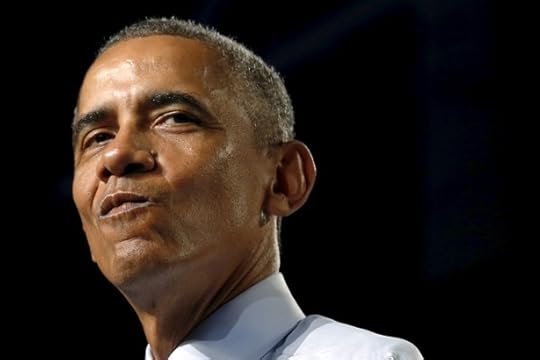
The White House likes to make it seem as if President Obama is floating just a bit above the raucous race to succeed him. Sure, he’s keeping an eye on the whole thing. But he’s not really focused on it. The president isn’t even planning to watch Wednesday’s Republican debate, just like he didn’t see the last one.
“He’s got better things to do,” spokesman Josh Earnest told reporters Tuesday.
Right.
The latest evidence that Obama is actually paying very close attention to the presidential campaign came less than 24 hours later, when he used a forum with CEOs to renew his call for raising taxes on hedge fund managers by closing the so-called “carried-interest loophole” that allows them to skirt potentially millions of dollars in income taxes. Obama and congressional Democrats have been making that case off and on for years, but it has gone nowhere in Congress. On Wednesday, the president saw a fresh opening, and he seized it.
Speaking before the Business Roundtable, Obama noted that “two leading candidates on the Republican side” were now on the record in support of closing the loophole. He was referring to Donald Trump and Jeb Bush, who have each been touting their positions on the issue in recent weeks. Ending the tax break would force hedge-fund managers to pay the top income-tax rate of 39.6 percent on most of the profits they earn for other people, rather than the much lower capital-gains rate. The change wouldn’t be a major money-saver for the government (about $18 billion over a decade), but it has become a symbol of how the tax code benefits the wealthy.
“If we close the tax loophole, we could double the number of workers in America’s job training programs,” Obama said, even as he acknowledged that some in his audience opposed the change. “We could help another 4 million students afford college.” He continued:
These are sensible choices that if you were running your business and you took a look at it, you’d make that decision. Well, America should too. And this is an example of how we can maintain fiscal responsibility while at the same time making the investments that we need to grow.
There are all sorts of tax loopholes and other provisions that Obama has targeted over the years as a means of raising revenue and reducing inequality. But only the relatively obscure carried-interest loophole now has the support of both the leading outsider Republican candidate and its most prominent establishment favorite—a pretty powerful combo with which to prod the GOP Congress.
The president wants lawmakers to change the provision as part of the budget their negotiating for next year. That remains unlikely, however. While Obama wants to use the revenue to pay for additional spending, Republican leaders (including Bush) have said closing loopholes should offset reductions in tax rates as part of a broader overhaul.
The larger significance of Obama’s call on Wednesday is that it shows how the White House is planning to try to take advantage of the GOP primary circus. The president has begun pushing back on Trump’s overheated rhetoric and his down-on-America tone. (America is already great, Obama is insisting. Take a look at the last five words of his tweeted message to 14-year-old Texas teen Ahmed Mohamed.) Now he's also using the emerging policy divisions in the GOP field to build momentum for pieces of his agenda and put pressure on the Republican majority in Congress.
The strategy might not result in immediate policy victories for Obama on Capitol Hill, but at minimum, it should give Democrats a handy wedge in 2016 and push one important tax loophole for the wealthy a little closer to extinction.









A Smaller Debate That Offers a Bigger Opportunity
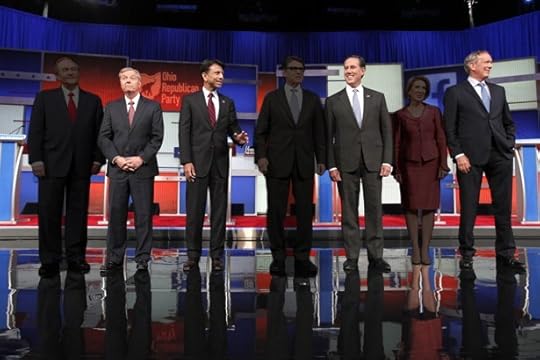
For Bobby Jindal, Rick Santorum, Lindsey Graham, and George Pataki, let’s start this Republican Debate Night with the bad news: You are all still sitting at the kids table. Stuck on the undercard. Not cool enough to join the popular (well, relatively speaking) GOP candidates in prime time.
But now the good news: There’s hope.
The four Republican also-rans who will take the stage at 6 p.m. for Part 1 of CNN’s debate on Wednesday now know that there’s a path out of political oblivion. For inspiration, they just need to look to Carly Fiorina, who seized the opportunity provided by last month’s Happy Hour debate. She performed well, moved up in the polls, and after an effective lobbying campaign against CNN, graduated to the main stage, where she will join 10 other candidates in the much more crowded prime-time contest.
In the Survivor-style race for the Republican presidential nomination, Fiorina was a winner in the first round. She moved up and out of the basement. The clearest loser was Rick Perry, who barely missed the cut for the prime-time debate in August, delivered a middling performance at 5 p.m., saw his fund-raising dry up, and ultimately bowed out of the race late last week. Then there is Jim Gilmore, the longest of the remaining GOP long shots, who now sits in a kind of political purgatory after CNN excluded him for Wednesday’s debate altogether because he can’t even muster 1 percent in the polls. The one-time (long-ago) Virginia governor is an officially-declared candidate for president, but as the Washington Post’s David Farenthold recently observed, he’s barely campaigning for the office. Gilmore says he will live-tweet the debate in absentia. He has 1,400 followers.
Whether for positive or negative reasons, the smaller crowd on the stage for the Happy Hour debate presents a huge opportunity for Jindal, Santorum, Graham, and Pataki. Rather than scrambling for scraps of air-time with six other contenders—or 10 others, at the later debate—they will each have plenty of time over the course of an hour and 45 minutes to introduce themselves to voters and make their case for the presidency. The undercard debate will even be starting an hour later this time around, which could help boost the audience a bit. And the relatively lower-profile stature of the candidates could accrue to their benefit: As Molly Ball notes, the main debate will revolve to a large extent around Donald Trump, and there won't be any outsized personalities on the stage at 6 p.m. (The flip side, of course, is the earlier debate could wind up being a total snooze fest.)
How the lower four will use their ample camera time is the question. Expect Jindal, the Louisiana governor, to take on Trump, who he has called “a madman who must be stopped.” The destroy-Donald strategy didn’t work so well for Perry, but from where he stands in the polls, Jindal just needs the headlines. Santorum has been unable to replicate his surprising 2012 success in a much larger 2016 field. He’s been talking a lot about Kim Davis, the Kentucky clerk jailed for refusing to issue marriage licenses for same-sex couples. Lindsey Graham’s message is easier to predict: He’ll criticize President Obama’s foreign-policy and the nuclear deal with Iran. And Pataki? He’s focused almost entirely on New Hampshire, but he’s been outflanked there by John Kasich, another GOP governor trying to attract voters who think the party has veered too far to the right. Expect Pataki to keep reminding viewers he was governor of New York on 9/11 and, since the debate is in California, to offer himself up as a candidate who has won three elections in a blue state.
With just four candidates on the stage, the undercard debate may be the more substantive contest on Wednesday, and for each of the contenders, the stakes will certainly be higher: A good performance can result in a better time-slot in October, while a bad one could send them home for good.









America’s Poverty Problem Hasn’t Changed

On Wednesday, the Census Bureau released its latest data on income and poverty for the country, and despite a falling unemployment rate and a rising GDP—two promising macroeconomic signs—things haven’t improved all that much for American families in the past year.
More From What Incarceration Costs American Families Is Prohibition a Good Idea After All? The Empty Promises of For-Profit Colleges
What Incarceration Costs American Families Is Prohibition a Good Idea After All? The Empty Promises of For-Profit Colleges In 2014, median household income was reported as $53,657—statistically the same as it was in 2013. The same stagnation held when it came to the poverty rate, with about 14.9 percent of Americans, or almost 47 million people, falling below the poverty threshold of about $24,000 for the year.
The news was, of course, worse for minorities and women. The rate of poverty among blacks and Hispanics was well over 20 percent. Women, too, remained more likely to struggle to make ends meet, especially elderly women, whose poverty rate was nearly double that of men in the 75 and older age group. And though more women than ever are participating in the workforce, with 61 percent of women employed full time in 2014, their earnings remained about 79 percent of their male colleagues.
Poverty Rate by Race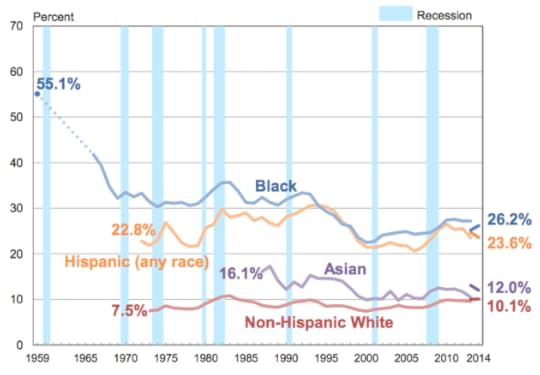 Census
Census None of this is especially revelatory—America’s poverty problem is basically the same. So the biggest news in the data dump was the shifting methodology behind it all. For years, critics have said that the means of measuring poverty in the U.S. is overly simplistic. It includes forms of income such as social security and unemployment, but excludes other things that shape families’ finances, such as food stamps and tax credits. It also ignores that the price of some services, such as health care, have escalated more quickly than inflation has, and that the costs of childcare matters more to families than it did 50 years ago, when fewer women were working.
That’s why for the first time, the bureau released a supplemental poverty measure along with its official figures. According to the supplemental data, the poverty rate in the U.S. was about 15.3 percent—0.4 percentage points higher than the report’s official rate. But the additional measure shows differences in age groups. For instance, those under the age of 18 have a poverty rate of 16.7 percent—quite a bit lower than the 21.5 percent reported in the main findings. For older Americans, the tweaked metrics paint a grimmer picture, with the share of seniors living in poverty reported as nearly 5 percentage points higher than the official measure.
Poverty Rates: Official Versus Supplemental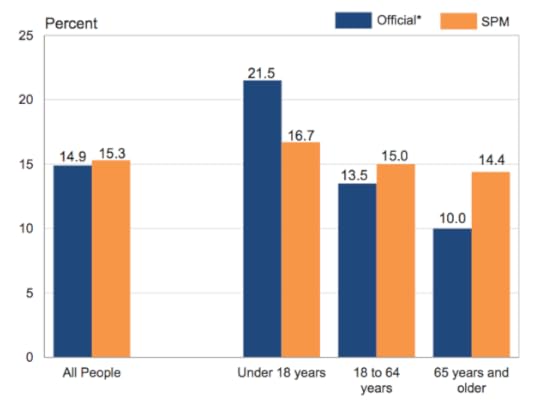 Census
Census The more inclusive measures might help monitor the effectiveness of programs meant to increase the well-being of specific populations, such as children or the elderly. Still, the use of an official, blanket income level remains a crude means of identifying families that are having a difficult time putting roofs over their heads or food on the table, especially considering the vast differences in cost of living around the country. To better understand the persistent poverty problem requires greater attention to nuanced and localized data that can better illustrate areas where the cost of essentials are outstripping income and benefits, and where families continue to suffer.









The Troubling Case of Richard Glossip
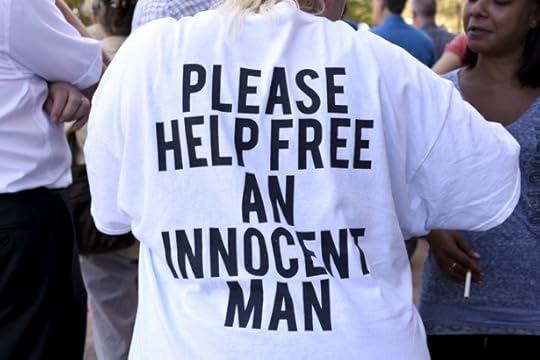
Updated on September 16 at 1:17 p.m. ET
Oklahoma’s highest criminal-appeals court granted Richard Glossip an eleventh-hour stay of execution Wednesday until September 30 to hear new evidence he may have been framed.
Glossip’s name is already synonymous with the problems plaguing American capital punishment. After the botched execution of Clayton Lockett in Oklahoma last year, he and three other death-row inmates sued the state department of corrections to prevent their own executions with the controversial sedative midazolam. In Glossip v. Gross, the U.S. Supreme Court upheld Oklahoma’s lethal-injection protocol in a sharply divided 5-4 opinion.
Now, Glossip is challenging his conviction itself on grounds of innocence. A number of excellent reporters have written extensively about the case and the questions swirling around it. Liliana Segura and Jordan Smith at The Intercept first wrote about Glossip’s case in July, just days after the Supreme Court ruled against him and the other death-row inmates.
All sides agree that Justin Sneed fatally bludgeoned motel owner Barry Van Treese to death in January of 1998. But the stories diverge on whether Glossip commissioned Sneed to commit their boss’s murder. Murder-for-hire can make the conspirator eligible for the death penalty in many states, even if he or she was not present at the murder. But Segura and Smith reported that Sneed’s daughter tried to alert Oklahoma officials last October that her father’s testimony about Glossip’s role in the murder could be inaccurate:
In a letter to the Oklahoma Pardon and Parole Board, she wrote that, based on her many communications with her dad, she “strongly believe[s]” that Richard Glossip is an innocent man. “For a couple of years now, my father has been talking to me about recanting his original testimony,” she wrote. “I feel his conscious [sic] is getting to him.”
The case for Glossip’s innocence hinges solely on whether or not Sneed lied. His motive would be obvious: Prosecutors spared Sneed the death penalty in exchange for his testimony against Glossip. In a recent interview with Cary Aspinwall at The Frontier, Sneed refused to recant his earlier testimony that Glossip paid him to commit murder. According to Aspinwall, Sneed’s family members suggest his daughter was manipulated into sending the letter, which didn’t reach the parole board in time to be considered.
As concerns about Glossip’s possible innocence grew over the summer, a broad array of public figures urged Oklahoma Governor Mary Fallin to stay Glossip’s execution for 60 days to allow new evidence to be heard, including Sister Helen Prejean, former Senator Tom Coburn, and former University of Oklahoma head coach Barry Switzer. Oklahoma City District Attorney David Prater dismissed their efforts a “bullshit P.R. campaign” on Monday.
Fallin announced Tuesday she saw “no reason to cast doubt on the guilty verdict reached by the jury or to delay Glossip’s sentence of death” and ruled out a temporary reprieve. Glossip’s legal team then petitioned the Oklahoma Court of Criminal Appeals, the state’s highest criminal-appeals court, to intervene. The court granted the stay less than eight hours before his scheduled execution at 5 p.m.









The Stealthy Humanism of Stephen Colbert
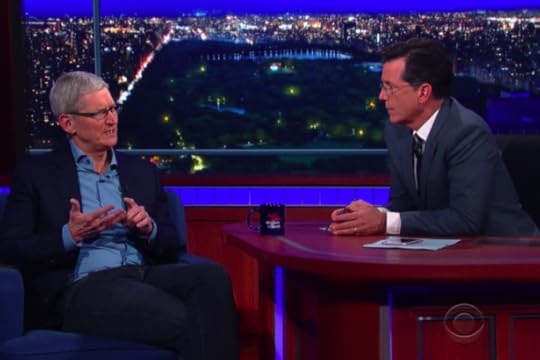
Stephen Colbert had Tim Cook on his show last night. The two talked about Siri, but also, less predictably, about corporate responsibility and Martin Luther King, Jr. and human rights.
The first section of the interview was pretty much an infomercial for Apple’s latest product, the iPhone 6s. Colbert had a prototype on-hand—in the newest color, rose gold, natch—and gave a detailed, gee-whiz-inflected preview of the device. The “3-D touch!” The “live photos”! The fact that the 6s will be charged with the same lightning cable used by recent iPhone models! (This is fortunate, because if Apple introduces another kind of charger, Colbert told Cook, “I will stab you in the neck with a fondue fork.”)
The focus of the conversation, though, was not on the tech stuff, but on the human stuff. Colbert asked Cook about the spate of new movies coming out that are critical of Steve Jobs. “I haven’t seen them, but the Steve I knew was an amazing human being,” Cook replied, dismissing the films and noting that, “I think that a lot of people are trying to be opportunistic.” Then Colbert asked his guest about Cook’s fairly recent decision to come out as gay. “Was that an upgrade, or just a feature that had not been turned on before?” Colbert asked, as the studio audience collectively guffawed. But “the reason I ask,” he continued, “is: Is that experience of growing up in Alabama, as sort of a resonant outsider because of your sexuality—did that inform, in any way, your trying to help people who are in hardship around the world?”
This is, of course, very much not the first time Cook has been asked about his sexuality—either before or after he came out last year. But connecting Cook’s experience to that of “people who are in hardship around the world” was a newer way to frame the question. Perhaps even a Colbertian one.
And: “It did,” Cook replied. He mentioned that his desk at Apple is decorated with a photo of Robert Kennedy and another of Dr. King. He thinks he has a responsibility not just to Apple’s investors and users, he suggested, but to justice itself. In this case, “It became so clear to me that kids were getting bullied in school,” Cook said.
Kids were getting basically discriminated against, kids were even being disclaimed by their own parents. And that I needed to do something. And where I valued my privacy significantly, I felt that I was valuing it too far above what I could do for other people. And so I wanted to tell everyone my truth.
But Colbert had more questions about the “people who are in hardship” in the world. “Many people have criticized Apple in the past about your supply chain and about the way your products are manufactured around the world,” Colbert commented, leading into a question that didn’t explicitly name the Foxconn factory, but strongly implied it.
Cook replied that Apple brings “college classes to our manufacturing plants” to help educate the plants’ workers. He replied that the company tries to educate those workers, too, teaching them about—a vaguely Orwellian phrase—“the rights as we see them.” He argued that Apple had high standards for what those rights actually entail.
He summed it up:
Just like our products are meant to give tools to everyone to do better things, to empower them to do things they couldn’t do otherwise, we want to leave the world better than we found it. And for us that means focusing on education, focusing on the environment, focusing on human rights. And so we put a lot of ourselves into these things.
On the one hand, of course, this was the typical stuff of PR-approved talking points. It was the CEO of Apple—whose public appearances, whether they take place on the WWDC stage or in the Ed Sullivan Theater, have the power to move markets—performing in a way that served himself, and his investors, and his company. Nothing he said was entirely new or extremely revelatory. Nor was anything, really, that he was asked.
What was remarkable, though, was the journalistic bent of Colbert’s questions. And what was even more remarkable than that was the brief conversation’s focus on values. This talk about human rights. This talk about Cook as a role model. This talk about charity. This sense that Apple isn’t just a company or a manufacturer of technology products, but also a steward of something broader and deeper.
Which goes without saying, sure, in the sense that every technology—every business—has an internalized morality. Apple’s, because of its products’ popularity, is simply more visible than most. But we don’t hear a lot about that stuff on late-night, network television, for the most part. Late-night comedy usually treats its audiences—perhaps tired from long days at work, perhaps dozing on the couch, right before bed—to wacky stories designed to make their tellers look charming. It often serves up goofy skits designed to make their performers look relatable. It traffics, for the most part, in fluff. It pretty much relies on it.
Cook’s interview was, say what else you will about it, not fluff. It was funny, at points, but it was, more than anything else, serious. It had a distinct whiff of humanism in it—one that has been showing up in other Colbert interviews, as well. Which might indicate, just a little bit, what The Late Show is going to become as it settles into itself. Because when you hear a guest uttering the phrase “human rights”—multiple times!—on a late-night comedy show, that says as much about the show as it does about the guest.









The Bonkers Best Time Ever With Neil Patrick Harris
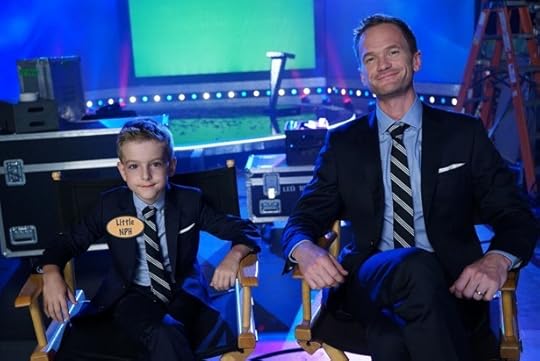
What do Maya Rudolph, Rosie O’Donnell, and the Osbournes have in common? At one point or another, with varying degrees of success, they’ve all made efforts to revive the TV variety show, and turn live song-and-dance into the ratings bonanza it used to be (albeit by relying on a tired formula featuring musical numbers, celebrity guests, and stilted audience interaction). NBC’s newest effort, Best Time Ever With Neil Patrick Harris, seems to be sticking to that template and may be equally doomed, but it has one trick up its sleeve: Even with all the strictures of the format, it’s genuinely demented.
Related Story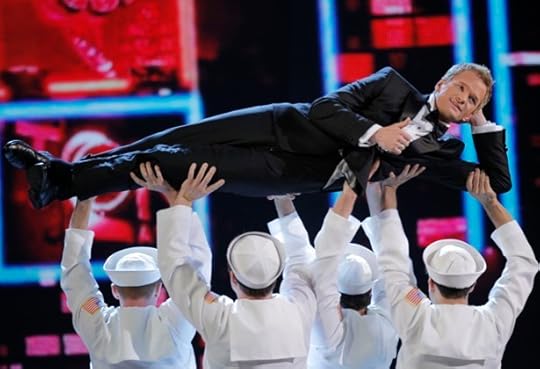
Neil Patrick Harris, Oscar Host: Meh
Recalling Harris’s many stints hosting awards shows like the Tonys, Emmys, and Oscars, Best Time Ever, which debuted Tuesday night, should be a lazy pitch down the middle, with Harris performing a big musical number and perhaps an elaborate magic trick (who can forget his doomed Oscar bit involving a sealed envelope filled with predictions). To his credit, Harris is aiming in an entirely different, and much more peculiar, direction. The premiere of Best Time Ever was a truly chaotic series of stunts, and enjoyment of it probably derives from just how staged you thought the audience interaction was. Either way, at a certain point it had a manic energy no other variety show of recent decades has come close to capturing, and that in itself is a strange sort of achievement.
To open the show, Harris revealed he had infiltrated the wedding of one couple in the audience months before, bringing them onstage and surprising them with creepy photobombs showing him in the background at their blessed day. Later, he activated cameras and microphones that were planted in the houses of viewers at home, supposedly against their knowledge, so they could sing live karaoke with Gloria Gaynor. By the time Harris was challenging Reese Witherspoon to race him to the top of a steel crane, the show’s increasingly chaotic atmosphere finally felt like it was boiling over into something genuinely spontaneous. No doubt Best Time Ever was a rigorously managed production from start to finish, but there was a faint glint of exasperation in Witherspoon’s eyes after she failed to beat Harris in their race atop an American Ninja Warrior edifice that was impossible to fake.
Perhaps the strangest, and most compelling, part of Best Time Ever was that it made no acknowledgement of just how weird and occasionally invasive Harris’s stunts were, with its host gently smiling and laughing all the while as he told an impassive-looking couple that he had been lurking in the background at their nuptials and rolling around in the honeymoon suite of their hotel before their wedding night. Witherspoon, the first in a revolving set of guest announcers, cheered him on from an onstage booth (before she was asked to take part in a ninja challenge, that is), and a tow-headed child in a suit was presented to audiences as “Little NPH,” at one point having a copy of Gone Girl snatched out of his hands because it “didn’t end well” for Harris’s character (himself a clingy stalker) in the film adaptation.
The simplest question to ask of such a baffling TV oddity is: Why does this exist?The simplest question to ask of such a baffling TV oddity is: Why does this exist? The variety format, outside of late-night talk shows and Saturday Night Live, hasn’t been a ratings winner for years, but NBC is clearly hoping that throwing a spectacular live event every week will draw audiences that are increasingly used to catching up on TV shows online. Musical events like The Sound of Music Live! and Peter Pan Live! marked the first wave, and the sitcom Undateable will perform its third season live every week starting in October, but Best Time Ever is bigger than either, and made game efforts to cross-promote with practically every other NBC brand. Carson Daly of The Voice was a guest, that show’s judges (Blake Shelton, Pharrell, Gwen Stefani, and Adam Levine) were part of another one of Harris’s pre-taped pranks, and the aforementioned American Ninja Warrior got a big old plug.
But it’s hard to imagine American audiences warming to Best Time Ever, no matter what Harris’s personal popularity might be. The show is based on the British hit Ant & Dec’s Saturday Night Takeaway, a variety show hosted by two super-popular comedians (glimpsed onstage at the end of the Best Time Ever premiere) who perform a similar mix of live comedy and stunts. But the British TV landscape has always been more suited to such theatrical antics, which never really went out of style. Unless it’s in a gameshow (and Best Time Ever had more than a whiff of The Price Is Right in its staged audience interactions), American TV has bade goodbye to those stagey traditions. Harris seems to know that, and clearly hopeful that by dialing Best Time Ever’s energy up to a thousand, he can reverse the trend. He’s probably wrong, but there’s something strangely compelling in watching him try.









Mindy Kaling Is Thirsty

When did “hard worker” become a backhanded compliment? When did “thirsty” become such a good burn? Why are we so weird about work, and about wanting, and about working hard to get the things we want?
You could say a lot about Mindy Kaling’s new memoir Why Not Me?—that it is, like its predecessor, extremely charming; that it offers a collegial mix of sincerity and sarcasm and self-deprecation and self-affirmation; that there’s a good chance it will make you love Kaling or at least want to chat with her over cocktails with “fizz” in their names—but maybe the main thing to say is this: The book is, at its core, a defense of work. It is a defense of striving, and wanting, and thirsting. It takes all the glib protestations of Hollywood doublespeak (“I woke up like this,” “omg I basically only eat fried chicken,” “they’re real,” etc.), and says to them: No. You are lying. You worked for what you got. You struggled, somehow, for it. Just own that.
Related Story
Kaling focuses, in large part, on the dirty mundanities that so often precede and accompany Hollywood success: the spackled makeup, the Spanx, the spray tans, the hair extensions, the long commutes, the late nights, the coffee, the drudgery. Kaling tells her reader (who is “probably a woman,” or perhaps “a gay man,” or maybe someone who “accidentally bought this thinking it was the Malala book”) about her early days in the writers’ room of The Office, when she was so shy she barely spoke aloud. “Years later,” she notes, “I realized that the way I had felt during those first few months was correct. I didn’t deserve to be confident yet.”
Later she’ll add: “If you believe in yourself and work hard, you have a fighting shot at having your dreams come true.”
It’s maybe the cheesiest line in a book that discusses, among much else, Kaling’s rise as a writer and performer on The Office, her brief romance with a White House staffer named Will, her long bromance with a fellow Office writer named B.J., her appreciation of McDonald’s breakfast sandwiches, and The Mindy Project’s “quick and painful rejection” from NBC, and then from Fox. But Kaling isn’t joking about the hard-work stuff. It’s the thing, she argues, that she owes her success to. It’s the thing to which she attributes her confidence as a performer and a person.
“I swear I’m not that Tiger Mom lady!” Kaling protests, just so we don’t get the wrong idea. “I don’t think you need to play the piano for 11 hours with no meals! Or only watch historical movies, then write reports on them for me to read and grade!” And yet “the truth is,” she notes, “I have never, ever met a highly confident and successful person who is not what a movie would call ‘a workaholic.’ We can’t have it both ways, and children should know that.”
It’s pretty much impossible not to compare Why Not Me? to Bossypants, Tina Fey’s memoir, and Yes Please (Amy Poehler’s) and Not That Kind of Girl (Lena Dunham’s) and I Don’t Know Where You Know Me From (Judy Greer’s) and even Kaling’s earlier memoir, Is Everyone Hanging Out Without Me? (And Other Concerns). These books take advantage of the myriad failings of the Miley Cyrus Industrial Complex to step in as role models for girls who are (or who at least think of themselves as being) smart and sassy and earnestly rebellious. Why Not Me? is another of these: It’s ultimately an advice book. And maybe the biggest piece of advice it has to offer to its young, impressionable readers is that self-confidence is a privilege as much as it is the thing that most direct-to-girls messaging assumes—a right. Confidence is something you earn, Kaling argues. And you earn it, specifically, by caring about things, by trying to get things accomplished, by working.
“There is a certain type of greasy hair that you get only when you are writing with no breaks,” Kaling confides, telling the story of her creation of The Mindy Project. “And I had it, big-time. If I breathed in deeply, I could smell my unwashed scent, and it was intoxicating. It smelled like hard work.”
“The truth is, I have never, ever met a highly confident and successful person who is not what a movie would call ‘a workaholic.’”That is, okay, a little bit gross. But it is also refreshing. It is, in its quiet way, revolutionary. We claim, being American, to appreciate The Value of Hard Work, to respect the quiet dignity of drudgery. We claim to respect goals not just achieved, but strived for, in a journey-as-destination kind of way. But those claims are, to some extent, lies. What we actually value—what we prove again and again to prioritize above all—is talent. That magical, mysterious quality that marries a person’s abilities with her desires, without the awkwardness of effort.
Nowhere is that more in evidence than in Hollywood. It’s a popular thing among celebrities—even, and especially, the ones who are supposed to be role models to young women—to deny the hard work that so often goes into becoming a star. (Stars, hanging out in the firmament, just are. That is a big part of their point.) And so we get the young ingenue dishing to Us Weekly about how she, like, loves cheeseburgers and totally hates the gym. We get the myth of “natural beauty.” We get the refusal of celebrities to acknowledge plastic surgery, or marriage counseling, or their involvement in the back-room work of contract negotiations.
All that ruins the illusion. Because the thing that is believed but not said is that work is dirty. It is sleepy and rumpled and over-caffeinated and intoxicated and unglamorous and unsexy. It tries, ugh, soooo hard. It is thirsty.
So while Kaling’s book is a confectionarily charming memoir, it is also something of a statement. It’s an attempt to reclaim work—the wanting, the striving, the trying—as a value unto itself. And as the thing that puts all the other things we actually do value, whether it’s confidence or beauty or success, into perspective. As Kaling sums it up:
People talk about confidence without ever bringing up hard work. That’s a mistake. I know I sound like some dour older spinster on Downton Abbey who has never felt a man’s touch and whose heart has turned to stone, but I don’t understand how you could have self-confidence if you don’t do the work.
I work a lot. Like, a lot. I feel like I must have been watching TV as a kid and that cartoon parable about the industrious ants and the lazy grasshopper came on at a vital moment when my soft little brain was hardening, and the moral of it was imprinted on me. The result of which is that I’m usually hyper-prepared for whatever I set my mind to do, which makes me feel deserving of attention and professional success, when that’s what I’m seeking.









Inventing While Muslim

Updated on September 16 at 1:13 p.m. ET
A 14-year-old Texas boy tried to impress his teacher with a homemade clock in the first few weeks of high school. Ahmed Mohamed’s invention landed him in handcuffs when officials at his school in Irving thought it resembled a bomb and called police.
Ahmed vowed he will never take an invention to school again—though he may be taking one to the White House.
Here’s the background: Ahmed said he took the clock to school on Monday because none of his teachers at MacArthur High “know what I can do.” The Dallas Morning News reports that the ninth-grader makes his own radios and repairs his own go-kart. The newspaper says the door to his bedroom “marks the border where the Mohamed family’s cramped but lavishly decorated house begins to look like the back room at RadioShack.” Here’s more:
Ahmed’s clock was hardly his most elaborate creation. He said he threw it together in about 20 minutes before bedtime on Sunday: a circuit board and power supply wired to a digital display, all strapped inside a case with a tiger hologram on the front.
He showed it to his engineering teacher first thing Monday morning and didn’t get quite the reaction he’d hoped for.
“He was like, ‘That’s really nice,’” Ahmed said. “‘I would advise you not to show any other teachers.’”
But the clock’s alarm went off during English and his teacher complained. Ahmed showed her the invention after class.
“She was like, it looks like a bomb,” he told the newspaper. “I told her, ‘It doesn’t look like a bomb to me.’”
She kept the clock. In the sixth period, the principal and a police officer pulled the 14-year-old out of class. He was taken to another room where he found four other officers waiting. One who sat in the back, he says, said: “Yup. That’s who I thought it was.”
Ahmed says he felt conscious of the color of his skin and his name. The questions, he says, kept coming.
“They were like, ‘So you tried to make a bomb?’” Ahmed told the Morning News.
“I told them no, I was trying to make a clock.”
“He said, ‘It looks like a movie bomb to me.’”
A police spokesman, James McLellan, told the newspaper that while Ahmed never said the device he built was anything but a clock, officers suspect he wasn't telling them the whole story.
“It could reasonably be mistaken as a device if left in a bathroom or under a car,” he said. “The concern was, what was this thing built for? Do we take him into custody?”
Ahmed was led out of the school at 3 p.m., his hands cuffed behind him. He was sent to a juvenile detention center where he was fingerprinted, and then reunited with his parents. The principal suspended him for three days.
Ahmed's sister told me to post this. Yes this situation is real for those questioning. pic.twitter.com/Oxd0JxUS6O
— Prajwol/Ru (@OfficalPrajwol) September 16, 2015
“He just wants to invent good things for mankind,” said Mohamed Elhassan Mohamed, Ahmed’s father, an immigrant from Sudan. “But because his name is Mohamed and because of September 11, I think my son got mistreated.”
At a news conference Wednesday, Irving Police Chief Larry Body said Ahmed would not be charged.
“We have no evidence to support that there was an intention to create alarm or cause people to be concerned,” he said.
A letter from Dan Cummings, the school principal, to parents said the “Irving Police Department responded to a suspicious-looking item on campus yesterday. We are pleased to report that after the police department’s assessment he item discovered at school did not pose a threat to your child’s safety.”
I recommend using this opportunity to talk with your child about the Student Code of Conduct and specifically not bringing items to school that are prohibited. Also, this is a good time to remind your child how important it is to immediately report any suspicious items and/or suspicious behavior they observe to any school employee so we can address it right away.
The Council on American-Islamic Relations said it was investigating Ahmed’s case.
The Guardian adds that this is the second high-profile case involving Islam in Irving, about 15 miles northwest of Dallas. Beth Van Duyne, Irving’s mayor, “became something of a national celebrity after she accused Islamic leaders of “bypassing American courts” by offering voluntary Shariah-law mediation to worshippers.”
The case has received national attention.
Cool clock, Ahmed. Want to bring it to the White House? We should inspire more kids like you to like science. It's what makes America great.
— President Obama (@POTUS) September 16, 2015
Assumptions and fear don't keep us safe—they hold us back. Ahmed, stay curious and keep building. https://t.co/ywrlHUw3g1
— Hillary Clinton (@HillaryClinton) September 16, 2015









Atlantic Monthly Contributors's Blog
- Atlantic Monthly Contributors's profile
- 1 follower



